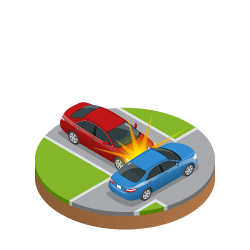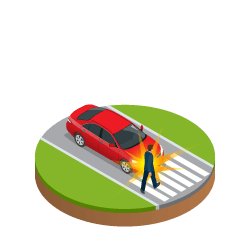Get the cheapest quotes for your car
Compare providers in your area.
Compare providers in your area.
3 million
people trust Finder to compare car insurance
270,000
drivers saved on car insurance with Finder
$500
average annual savings
Make sure you’re comparing equivalent features to get the strongest insurance rates.
The average cost of car insurance is $1,300 a year or $108 a month, but rates vary depending on your car’s make, model and year, driving record, location, age, credit score and other factors.
For example, expect higher insurance rates if you live in a high-claims area, like a big city or an area with a high rate of uninsured drivers or car theft.
You typically pay your premiums monthly, yearly or every six months. Insurance companies may accept electronic transfers, credit cards or checks.
You might score discounts for paying for your policy annually, setting up autopay or getting bills online.
Your premium is what you pay every month to keep your policy and coverage. The deductible is what you pay in an accident before you can get a claim payout.
If lowering your car insurance premium is your main priority, switching car insurance could be one of the best ways to save. Compare auto insurance quotes with sample rates from insurers for California drivers.
| Company | Average annual rate | Average monthly rate |
|---|---|---|
| Geico | $394 | $33 |
| USAA | $416 | $35 |
| Progressive | $536 | $45 |
| Grange | $557 | $46 |
| Mercury | $564 | $47 |
| Kemper | $615 | $51 |
| 21st Century | $651 | $54 |
| Allied | $666 | $55 |
| Nationwide | $666 | $56 |
| Allstate | $666 | $59 |
| Liberty Mutual | $709 | $59 |
| State Farm | $726 | $61 |
| The Hartford | $727 | $61 |
Umbrella insurance is liability coverage that protects you and family members living in your household over and above your existing liability insurance, like home or car liability coverage. Think of it as an extra safety net that pays for medical bills if you injure someone or pays to repair or replace someone’s belongings that you damage. Umbrella liability insurance also pays for legal fees if someone takes you to court and expenses go beyond your other liability insurance.
Say you needed to make a claim on your car, home, renters, boat or other personal liability insurance. Umbrella coverage kicks in with extra liability coverage if the damage exceeds the maximum limits on your current policies or if you don’t have an existing policy that covers the liability.
Umbrella insurance covers a wide range of scenarios involving liability:
You might need an umbrella policy if you:
You might not need umbrella coverage if you:
To find how much umbrella insurance you need, review your net worth, home value, retirement plans and investments and total your assets together. Then, see if your current car, home or renters liability limits meet or go beyond the dollar value of your assets. The rule of thumb is to buy enough umbrella insurance coverage to equal your net worth.
However, consult a financial adviser if you have significant assets, like a net worth over $500,000. The general rule is based on how liability lawsuits often use your current assets or insurance coverage to settle the case. However, a personal financial adviser can help you understand whether your finances warrant more or less coverage than other people.
Umbrella policies range from $500,000 to $5 million in coverage. However, you also need a minimum amount of liability coverage on your home and auto policies to qualify, such as $300,000 bodily injury liability and $100,000 of property damage liability on your auto insurance policy.
For example, say your home is worth $400,000, your cars are worth $50,000, and your savings and retirement are worth $250,000. Your net worth totals $700,000 minus any debts you have. An umbrella policy of $1 million should fully protect all your assets if you’re sued, even in a worst-case scenario.
A $1 million umbrella policy typically costs between $150 and $300 each year, according to the Insurance Information Institute.
Those rates may seem lower than a typical car or home insurance policy because umbrella coverage works in addition to your home and auto policies. Your risk of maxing out the coverage is lower with this policy.
Umbrella insurance doesn’t have a deductible, but it might come with a self-insured retention amount. This functions similarly to a deductible in that you may have to pay out of pocket but differs in that the self-retention amount doesn’t reduce your claims payout.
The general rule of thumb is that self-insured retention only applies if the umbrella policy covers you for something that your underlying insurance doesn’t. Otherwise, your underlying policies have their own deductible, so you won’t be hit twice.
If you have a personal umbrella policy, your premiums likely won’t be tax-deductible. However, if your umbrella policy is supplementing other business policies you have, your premiums may be tax-deductible.
Watch out for some areas that your umbrella insurance doesn’t cover, including:
No one wants to overpay for insurance. The best way to save on car insurance is by shopping around.
Each state holds its own minimum car insurance requirements, and deciding on other coverages depends on how much you’re willing to pay out of pocket in the event of a claim.
Car insurance rates can vary a lot based on your address in the US. The national average is $1,300 a year, but drivers in less populated states like Maine pay only $864, while Michigan drivers facing unique insurance laws see premiums around $2,394. Hover over each state of interest to see what average insurance rates are.
In most states, each driver should have at least liability coverage and sometimes personal injury protection or uninsured driver coverage. The types and limits of car insurance coverage you need are different for every state.
When shopping for car insurance, you might see limits written like 25/50/25, which means $25,000 bodily injury liability and $50,000 bodily injury per accident and $25,000 property damage limit.

Covers costs from injuries you cause another person in an accident.

Covers damage you cause to someone else’s property in an accident.

Covers medical services after an accident, regardless of fault.

Covers your own injury or car damage costs if the at-fault driver in an accident doesn’t have car insurance or doesn’t have enough coverage.
Uninsured motorist coverage can be valuable if you’re involved in an accident with another party who’s uninsured or doesn’t have enough insurance to cover all damages.
There are two types of uninsured motorist coverage.
Many insurance providers don’t include roadside assistance as part of a bare-bones, liability-only plan. However, if you’re in an accident and your car is too badly damaged to drive, the at-fault driver’s liability insurance should cover towing your vehicle to the nearest repair shop.
Roadside assistance is typically considered an add-on, and it’s often only available if you have comprehensive and collision coverage. That means you’ll likely need more coverage than liability only to take advantage of your provider’s towing services.
If you’re driving a car that’s prone to breaking down, ask your provider about plans that include roadside assistance. Other options include joining an auto club like AAA. Although you’ll pay an annual membership fee, you’ll gain access to towing and other important roadside emergency features.
![]()
Kirby George
Farmers Insurance, Licensed Insurance Agent
The biggest mistake I see people make is shopping for price.
When shopping for a car, a house or even a sweater, the average consumer understands they’re going to get what they pay for. If you want a Cadillac, you’re going to have to pay more than you would for a Ford.
If you want a brand-new 2,500-square-foot home, you expect to pay more than you would for a 20-year-old mobile home. When you shop for clothes, you pay more for new than you do at a thrift shop. Insurance is no different.
Your insurance quote comparisons look different across several companies because insurers use info about you to determine your driving risk and set your quotes.
This info is based on factors like where you park and how many miles you drive, including 10 factors that affect your rates the most:
A car insurance quote gives you an estimate of how much you’ll pay for car insurance with a particular insurer. Car insurance policies are usually rated for six- or 12-month periods.
You also might see your coverage limits written as 50/100/25. These numbers represent the dollar amount of coverage you have for physical damage and bodily injury liability:
When you decide on a company, the insurer will determine your rate after considering your motor vehicle record and the payment plan you want.
Check out the top 50 American car models, and find out what makes them American.
Learn the basic steps for transferring your car registration from another state or previous car.
No receipts? See how you can still get your insurance claim paid with different types of policies.
Know what to do after a license suspension, like whether you can drive or what fees to pay.
How to get your license back after a suspension in Maryland.
Learn about common scams, warning signs and what to do if you suspect fraud.
Get your car fixed and settle your insurance claim after an accident.
Find out if your car insurance policy will cover you for paint damage and how to get your car’s paint job back in great condition.
Learn how to transfer a car title, add or remove people on a title and recover a lost title.
Find your car’s post-accident value and see whether you could file a diminished value claim.